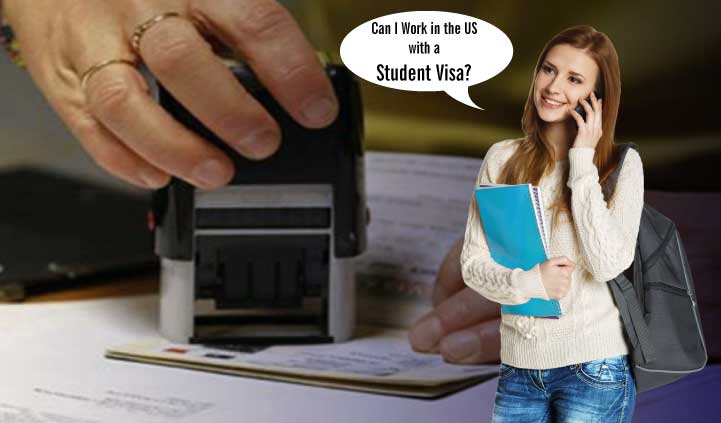If you are in the US with a Student visa, strict rules regulate the type of employment that you can lawfully engage in while in the USA.
Whether you are already studying in the US as an overseas student or perhaps you are looking at your options to apply to study in the US, it will be important to understand that a student visa stipulates a number of conditions which you must adhere to in order to maintain your lawful status. One such condition relates to employment and whether you can work in the US with a student visa.
The rules for combing work and study for non-US nationals vary with the category of visa that is held, the nature of the work sought among other factors. We take a look at what overseas students are permitted to do to ensure they follow the visa rules.
Apply for OPT Jobs in Virginia
Can I work in the US with an F-1 Visa?
An F-1 visa is a nonimmigrant visa for international students undertaking a full-time course of academic study at a US school or academic institution certified by the Student and Exchange Visitor Program (SEVP). The F-1 category is open to any overseas student enrolled in a program or course of study at a SEVP-approved school or academic institution in the United States culminating in a degree, diploma or certificate.
The Department of Homeland Security outlines four different ways for non-US students to legally work in the US under a F1 visa:
- On-Campus Employment
- Off-Campus Employment
- Curricular Practical Training
- Optional Practical Training (OPT)
On-Campus Employment
During your first year of academic study, employment can only be ‘on campus’. On-campus employment refers to work that takes place on campus or, alternatively, at an off-campus location that is educationally affiliated with the school.
This means that you could work somewhere on your school’s campus, such as a library, bookstore or cafeteria, or you could undertake work at an off-campus site that is affiliated to your school, such as a research lab.
This type of employment is the only work you are legally permitted to undertake during your first academic year, although you will be limited in the number of hours you can work when school is in session.
Even if you work more than one on-campus job, your total combined hours cannot exceed 20 per week during term. That said, during extended holidays and breaks, you will be permitted to work full-time.
You will not need to apply to USCIS for work authorization for on-campus employment.
Off-Campus Employment
After your first year of study, you may be permitted to take on off-campus employment. Off-campus employment is to be authorized by the Designated School Official (DSO) and must be for fewer than 20 hours per week in the form of curricular practical training (CPT) such as internships and employment in your field of study.
Off-campus employment refers to work that takes place outside of your school or academic institution and, typically, is only available to non-US students who satisfy the following criteria:
- You have completed one full academic year, and
- You are experiencing severe economic hardship, or
- You are seeking special student relief due to an emergent circumstance.
SEVP defines severe economic hardship as “a financial condition caused by unforeseen circumstances beyond the student’s control that make it difficult for a student to continue education in the United States”.
A qualifying economic hardship can include things like large increases in tuition or living costs, a substantial decrease in the relative value of currency the student depends upon to pay expenses or unexpected changes in the financial conditions for a student’s sources of financial support.
Curricular Practical Training
Curricular Practical Training (CPT) is work experience that forms an integral part of your curriculum, designed to give you practical real-life experience in your field of study. This could be, for example, an internship with a potential employer.
To qualify for CPT, you must again have completed one full academic year, unless you are a graduate student whose program requires immediate placement training. However, unlike other employment categories, CPT can be full time, with no weekly hour limit.
Please note, if you undertake more than one year or more of full-time CPT, you will become ineligible for Optional Practical Training (see below).
Optional Practical Training
F-1 students can, in addition to employment as above, work on optional practical training (OPT) for up to one year after completion of their academic program.
Optional Practical Training (OPT) refers to temporary employment relating to your field of study, for example, if you are studying science you ought to be permitted to work in a laboratory.
There are two different types of OPT: pre-completion and post-completion. Pre-completion OPT is available to students who have completed one full academic year at a US college or university. As with most other forms of student employment, you can work up to 20 hours a week when school is in session, or full time when it’s not.
Post-completion OPT, as the name suggests, is for students once they have graduated. Those who are authorised for post-completion OPT can work on either a part-time or full-time basis for a period of up to 12 months.
Please note that if you undertake both pre- and post-completion OPT, the 12-month maximum work period will be divided between the two.
Finally, having participated in a period of post-completion OPT, for those of you who have studied science, technology, engineering or mathematics, you may also be eligible for a STEM OPT extension, namely a 24-month period of temporary training that directly relates to your program of study.
Source:- http://bit.ly/2YliOQB
Disclaimer:- https://bit.ly/2S00nLJ

